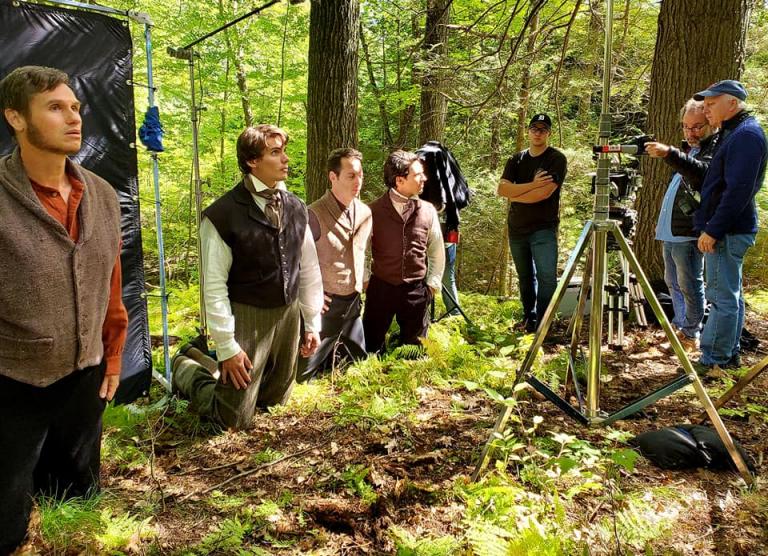
(A still photograph by James Jordan taken on the set of the Interpreter Foundation’s “Witnesses” film project back in 2019.)
In all likelihood, today marks the 192nd anniversary of the experience of Oliver Cowdery, Martin Harris, David Whitmer, and Joseph Smith with the golden plates of the Book of Mormon, as well as with an angel and the confirming voice of God. If the Interpreter Foundation’s Witnesses film is playing in your vicinity, today — family night! — would be a wonderful day to see it while it’s still on theater screens, and even to bring friends and family along. Go to witnessesfilm.com to find out where it might be playing, and to request it if it hasn’t yet come to your area.
And while you’re waiting for the movie to begin, you can read one or more of these articles from a previous issue of Interpreter: A Journal of Latter-day Saint Faith and Scholarship:
Noel B. Reynolds, “The Status of Women in Old Testament Marriage”
Review of Gordon Paul Hugenberger, Marriage as a Covenant: A Study of Biblical Law and Ethics Governing Marriage Developed from the Perspective of Malachi (Supplements to Vetus Testam, Book 52). Leiden, Netherlands: Brill, 1994. Pp. xx + 414. Paperback reprint edition with a modified subtitle published in 2014 by WIPF & STOCK, Eugene, Oregon. 343 pages, plus bibliography and four indices.
Abstract: In his book Marriage as a Covenant, author Gordon Paul Hugenberger begins with the late 20th century Bible-studies insight that in Israel, covenants were devices used to make binding on unrelated persons the same obligations blood relatives owed to each other. So by covenant, marriage partners became one bone and flesh. This thorough study of the Hebrew Bible and related literatures argues that the view of marriage as a covenant in Malachi 2:10‒16 echoes the first marriage in Genesis 2 and is consistent with the other passages in the Bible that have often been mistakenly interpreted to promote a patriarchalist view denigrating the position of wives vis-à-vis their husbands.
Abstract: Easters come year after year, reminding us of new life brought to the children of men by the eternal atoning sacrifice of our Lord and Savior, Jesus Christ. He grants us peace, forgiveness, grace, mercy, contentment, and joy in our hearts, and thus we gratefully testify of our everlasting redeeming Savior. All things bear witness of Jesus Christ. The Lord spoke thus face-to-face with Moses upon a high mountain: “And behold, all things have their likeness, and all things are created and made to bear record of me, both things which are temporal, and things which are spiritual; things which are in the heavens above, and things which are on the earth, and things which are in the earth, and things which are under the earth, both above and beneath: all things bear record of me.”1 The intent of this article is to discuss scriptures that bear testimony of the reality of the Lord’s infinite atonement, to express deep gratitude for our Savior, and to praise Him for His grace, mercy, wisdom, power, and holiness.
Stephen O. Smoot, “Approaching Abinadi”
Abstract: The recently released Abinadi: He Came Among Them in Disguise, a new book from Brigham Young University’s Book of Mormon Academy, offers readers multidisciplinary approaches to Mosiah 11–17 that highlight the literary, historical, and doctrinal richness of the story of Abinadi. Students and scholars of the Book of Mormon are sure to benefit greatly from this new volume.
Review of Shon D. Hopkin, ed. Abinadi: He Came Among Them in Disguise (Provo and Salt Lake City: Religious Studies Center, Brigham Young University, and Deseret Book, 2018), 404 pp. $27.99.
Andrew C. Smith, “Abinadi: A Minor Prophet, A Major Contributor”
Abstract: The new edited volume Abinadi: He Came Among Them in Disguise, from the Book of Mormon Academy, is a valuable contribution to Book of Mormon studies. It should find a wide audience and stimulate greater and deeper thinking about the pivotal contributions of Abinadi to the Book of Mormon. It should, however, not be considered the end of the conversation. This review discusses the volume’s importance within Book of Mormon scholarship generally. It also highlights certain valuable contributions from each of the authors, and points out places where more can be said and deeper analysis is needed.
Review of Shon D. Hopkin, ed. Abinadi: He Came Among Them in Disguise (Provo and Salt Lake City, UT: Religious Studies Center, Brigham Young University, and Deseret Book, 2018), 404 pp. $27.99.
Abstract: To the ancient Israelite ear, the name Ephraim sounded like or connoted “doubly fruitful.” Joseph explains the naming of his son Ephraim in terms of the Lord’s having “caused [him] to be fruitful” (Genesis 41:52). The “fruitfulness” motif in the Joseph narrative cycle (Genesis 37–50) constitutes the culmination of a larger, overarching theme that begins in the creation narrative and is reiterated in the patriarchal narratives. “Fruitfulness,” especially as expressed in the collocation “fruit of [one’s] loins” dominates in the fuller version of Genesis 48 and 50 contained in the Joseph Smith Translation, a version of which Lehi and his successors had upon the brass plates. “Fruit” and “fruitfulness” as a play on the name Ephraim further serve to extend the symbolism and meaning of the name Joseph (“may he [God] add,” “may he increase”) and the etiological meanings given to his name in Genesis 30:23–24). The importance of the interrelated symbolism and meanings of the names Joseph and Ephraim for Book of Mormon writers, who themselves sought the blessings of divine fruitfulness (e.g., Lehi, Nephi, and Jacob), is evident in their use of the fuller version of the Joseph cycle (e.g., in Lehi’s parenesis to his son Joseph in 2 Nephi 3). It is further evident in their use of the prophecies of Isaiah and Zenos’s allegory of the olive tree, both of which utilize (divine) “fruitfulness” imagery in describing the apostasy and restoration of Israel (including the Northern Kingdom or “Ephraim”).
Stephen O. Smoot, “Pressing Forward with the Book of Abraham”
Abstract: The Book of Abraham continues to attract scholarly attention. New findings in the fields of Egyptology, Near Eastern archaeology, and Mormon history have highlighted the complexity surrounding the origins of the Book of Abraham and its relationship to the Egyptian papyri that came into the possession of Joseph Smith in 1835. A new introductory volume on the Book of Abraham by John Gee, An Introduction to the Book of Abraham, is an excellent resource that may help laypersons and scholars alike navigate this rapidly developing area of study.
Review of John Gee. An Introduction to the Book of Abraham. Salt Lake City and Provo, UT: Religious Studies Center, Brigham Young University, and Deseret Book. 2017. 184 pp. + index. $19.99 (print) and $11.99 (e-book).
Jeff Lindsay, “A Valuable Book for the Increasingly International Church”
Abstract: As the Church expands among the many nations, peoples, and tongues of the earth, new challenges arise that require the organization and the members of the Church to better meet the needs of the peoples in various nations and to cope with the specific challenges that may exist there. In this article I review a valuable book that can help in that expanding effort.
Review of Reid L. Neilson and Wayne D. Crosby, eds., Lengthening Our Stride: Globalization of the Church (Provo and Salt Lake City, UT: Religious Studies Center, Brigham Young University, and Deseret Book, 2018), 400 pp. $27.99.











